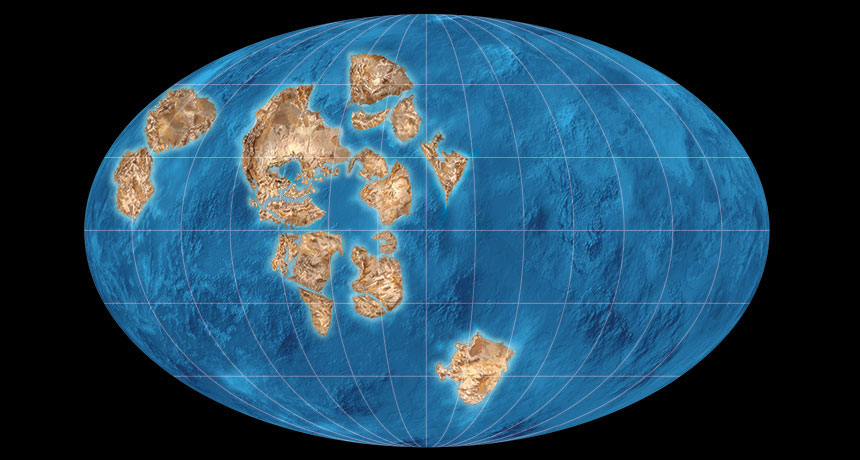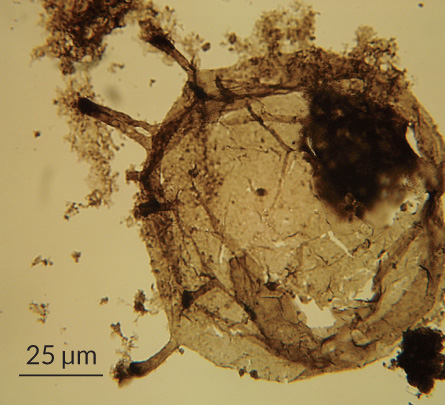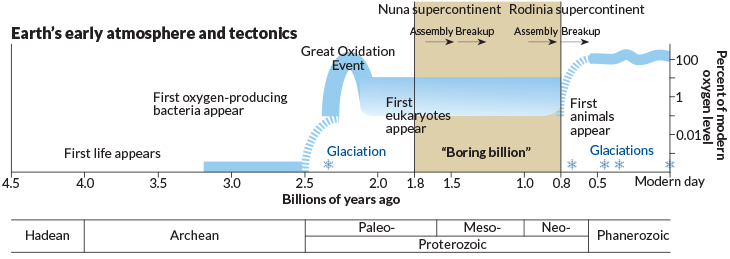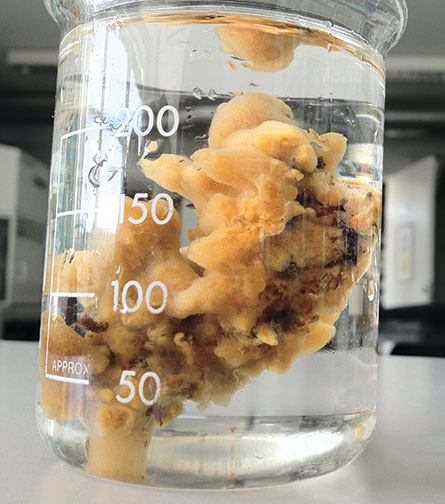New fascination with Earth’s ‘Boring Billion’
1.8 billion years ago, low oxygen may not have hindered life after all

DULLSVILLE Earth’s environment stagnated around 1.8 billion years ago. The breakup of the Nuna supercontinent, illustrated here during its disassembly 1.38 billion years ago, should have triggered an ice age but didn’t.
Nicolle Rager Fuller
- More than 2 years ago
Earth’s long history starts with an epic preamble: A collision with a Mars-sized space rock rips into the young planet and jettisons debris that forms the moon. Over the next few billion years, plot twists abound. The oceans form. Life appears. Solar-powered microbes breathe oxygen into the air. Colossal environmental shifts reshape the planet’s surface and drive the evolution of early life.
After this wild youth of rapid change, things slowed down. About 1.8 billion years ago, the climate stabilized. Oxygen levels steadied. Evolution seemingly stalled. For around a billion years, not a lot changed on planet Earth. Scientists called this interval the dullest time in Earth’s history. It came to be known as the “boring billion.”
But scientists are taking a fresh look at the boring billion and coming up with very different, downright fascinating, alternatives. Recent work recasts the era as a possibly pivotal (and definitely contentious) chapter in the story of life, which took a new twist not long after, with the introduction of animals.

Uncovering what shook Earth out of its monotonous midlife will reveal why complex life emerged, contends Timothy Lyons, a geochemist at the University of California, Riverside. It might even reveal what could support or hinder the emergence of creatures on faraway worlds.
“For a long time, the boring billion was commonly thought to be remarkably unremarkable,” Lyons says. “But it’s a critical chapter in the history of life on Earth, and there are basic questions we don’t understand.”
A breath of fresh air
The planet’s first whiff of oxygen came more than 3.2 billion years ago, following the evolution of the earliest photosynthetic microbes, cyanobacteria (SN Online: 9/8/15). These bacteria churn out oxygen into the environment. When the microscopic critters die, however, their remains decay and consume oxygen. Normally the life and death of a cyanobacterium would result in no net oxygen gain. Luckily for oxygen-loving life, accumulating sediments can bury the decaying organic matter under the seafloor and halt the drawdown of oxygen.
Before the boring billion, around 2.4 billion to 2.3 billion years ago, cyanobacteria flooded Earth’s atmosphere with oxygen (SN: 10/10/09, p. 11). This oxygen rise, nicknamed the Great Oxidation Event, permanently altered the planet’s chemical portfolio and purged the surface of nearly all oxygen-intolerant life.
The breath of oxygen ultimately spurred the evolution of complex life-forms called eukaryotes, with distinct cell nuclei and organelles. Early eukaryotes — the forebears of animals and plants — appeared at the start of the boring billion, 1.8 billion years ago. During their first few hundred million years, single- and multicelled eukaryotes eked out a marginal existence while bacteria and archaea unequivocally ruled Earth’s ecosystem (SN: 12/31/11, p. 12).
Article continues below graphic
Storied history
Life and oxygen on Earth have remained tightly entangled for billions of years. Following a rise known as the Great Oxidation Event, oxygen levels (blue) seemingly steadied for roughly a billion years, though precise data about much of the interval are lacking. During this time span, Earth remained warm with no glaciations (marked by snowflakes), despite supercontinent formation and breakup.

For decades, many scientists blamed the boring billion’s lack of eukaryote expansion and evolution, as evident in the fossil record, on low levels of oxygen. Today, oxygen makes up about one-fifth of Earth’s atmosphere; early studies pegged the boring billion as having 1 to 40 percent of modern oxygen concentrations. That made sense because most of the boring billion took place during the Mesoproterozoic era, when the rate of burial of decaying organic carbon matter under marine sediments flatlined. Oxygen production and consumption roughly canceled each other out.
Low oxygen isn’t the boring billion’s only defining feature — its changeless nature stands in marked contrast to the two dynamic eras that came before and after: the Paleoproterozoic and the Neoproterozoic. During those geologic bookends, wild swings in organic carbon burial were the norm. Similarly, while the Paleoproterozoic and Neoproterozoic included titanic freeze-overs of the planet, no great glaciations chilled the boring billion. As far as scientists can tell, warm and stable climate reigned for hundreds of millions of years.
The very stability of the boring billion left it overshadowed, scientifically, by its more lively neighboring eras, which have long seized the attention of researchers, says Linda Kah, a geologist at the University of Tennessee in Knoxville. “It’s easier to get funding if you go for the exciting spots,” she says. “You either want the Neoproterozoic when animals evolved or you want to go to the oldest, because the oldest is always cool.”
But on closer inspection, scientists are now finding the boring billion’s characteristic stability — unprecedented and unrepeated in Earth’s history — much harder to explain than the environmental shifts that punctuate other time periods.
“There’s no shortage of ways to stabilize the carbon cycle and oxygen levels,” says Yale geochemist Noah Planavsky. But for a lot of these stabilizing mechanisms, things get too stable. It becomes “difficult to imagine how you’d move on. We can imagine scenarios where we’re stuck in a boring system indefinitely,” he says. And that clearly didn’t happen.
Information from the time remains sparse, however, prompting new inquiries into what conditions were like for life 1.8 billion to 800 million years ago. So far, findings from these studies reveal a surprisingly suffocating world.
Chemical clues
Investigating ancient environments requires some clever chemical detective work. Because there is no ancient air or seawater remaining from billions of years ago, researchers hunt for evidence of primordial conditions embedded inside rocks.
Last year, Planavsky, Lyons and colleagues presented a new way to track oxygen during the boring billion. Scouring the chemical contents of marine sedimentary rocks laid down during the interval, the researchers found that oxygen levels were much lower than anyone had thought. While previous estimates predicted boring billion oxygen levels as high as 40 percent of modern concentrations, the new work suggests levels were only a few thousandths of that.
Planavsky and colleagues looked for signs that bacteria in ancient soils oxidized significant quantities of manganese atoms for energy, something that can happen only when oxygen levels are above about 0.1 percent of modern day.
These microbes lived on land, but the researchers hunted for evidence of manganese oxidation in what were once ancient shorelines. The chemical clues traveled from land to sea after the oxidized manganese in turn oxidized chromium atoms in the soil, leaving a telltale mark. Some varieties of chromium oxidize more readily than others. (The extra mass in chromium-53 makes it oxidize disproportionately more frequently than its lighter sibling chromium-52). Once oxidized, the chromium atoms could dissolve in water and wash into the ocean via streams. Any chromium imbalance created in the soil would ultimately be buried on the ocean floor.
After analyzing sedimentary rocks from the boring billion, the researchers reported last year in Science that no such chromium-53 surplus existed (SN: 11/29/14, p. 14). Oxygen levels during the boring billion must have been lower than the 0.1 percent threshold for manganese oxidation, the researchers argue.
“Oxygen was a lot lower than anyone imagined,” Lyons says, possibly low enough to prohibit the evolution of animals.
Oxygen forms the ozone layer in the atmosphere, but if oxygen levels were as low as Planavsky estimates, the ozone layer would have been razor thin, says Penn State geoscientist James Kasting. Such scant ozone makes the boring billion’s lack of ice ages harder to account for, he says. At the start of the Mesoproterozoic, the sun shined about 85 percent as brightly as it does today (SN: 5/4/13, p. 30). With that much less warmth from the sun, keeping the planet hot enough to curtail ice ages would require an intense greenhouse effect to trap Earth’s heat. But carbon dioxide concentrations alone weren’t high enough at the time to explain the above-freezing conditions, Kasting says.
Deep-sea microbes can produce methane that helps lock in Earth’s warmth, but the dearth of oxygen poses a problem: Methane degrades in ultraviolet light; if the ozone layer barely existed, as Kasting says, that methane wouldn’t stand a chance.
But greenhouse warming must have been in play because, tectonically, the boring billion wasn’t boring. Supercontinent formations and breakups expose new rock to the atmosphere. The new rock pulls carbon dioxide from the air, triggering ice ages. Yet in the middle of the boring billion, between 1.6 billion to 1.3 billion years ago, a supercontinent called Nuna assembled and broke up without causing any icing over. That lack of freezing temperatures suggests that the impact of plate tectonics on the planet’s climate “isn’t as strong as we had thought,” says Yale geoscientist David Evans. He suspects that, during the boring billion, living things influenced the environment and kept the planet warm.
Just how much life altered the environment, and just how strongly the environment controlled life, remains hard to suss out, Evans says. Some biologists propose that life did more than affect temperatures; it also triggered chemical and climatic changes that brought an end to the boring billion. Even paltry oxygen levels, those scientists contend, can’t stop the unending march of evolution.
Shallow breaths
Scientists have long assumed that animals could appear only once oxygen levels rose to about 6 to 10 percent of modern concentrations. Animals munch on other life-forms for energy. Obtaining and digesting food requires lots of oxygen. The low-oxygen conditions of the boring billion predicted by Planavsky and colleagues, therefore, seems an animal no-go.
At first glance, the fossil record appears to support that notion. The first fossilized animals, sponges, don’t appear until around 650 million years ago, coincident with a proposed rise in atmospheric oxygen. But fossils aren’t a perfect record, and other lines of evidence hint that animals originated tens of millions of years earlier, during the boring billion’s closing chapters.
Pinpointing when animals could have evolved, based on atmospheric conditions alone, is difficult because estimates of early animals’ oxygen needs are speculative. After millions of years of adaptation, no early animals are alive today to testify. Instead of guessing how ancient animals might have lived, geobiologists Daniel Mills and Donald Canfield of the University of Southern Denmark in Odense and colleagues tested a modern analog: the sea sponge. Their finding challenges the view that low oxygen levels during the boring billion prohibited the evolution of animals, Mills and Canfield wrote last year in BioEssays.

Mills dunked the yellowy globs into special water tanks. Slowly and in stages, he trimmed back the oxygen levels in the water while monitoring each sponge’s health. As oxygen levels plummeted, the sponges seemed unfazed. They thrived in water containing as little as 0.5 to 4 percent of modern oxygen levels, Mills and colleagues reported last year in Proceedings of the National Academy of Sciences. Some animals, it seems, don’t require that much oxygen after all.
“If we were to go back in time to the Mesoproterozoic, we’d suffocate and die if we stepped outside the time machine,” Mills says. “But that doesn’t mean that no animals could have survived in those conditions.”
While the sea sponge wasn’t tested under the skimpy 0.1 percent of modern oxygen conditions later predicted by Planavsky and colleagues, oxygen levels probably weren’t that low everywhere, Mills says. Pockets of oxygenated water, called oxygen oases, may have formed near clusters of oxygen-producing microbes. Small animals may have emerged in these havens and lived isolated lives until the global oxygen supply spiked after the boring billion, he proposes.
In this scenario, animals emerged after clearing an evolutionary hurdle, suggests Harvard paleontologist Andrew Knoll. Animals and other complex life have more intricate cell biology than early eukaryotes. The evolution of these sophisticated systems may have taken a relatively long time and wouldn’t be evident in the fossil record, he says.
“Animals had to be preceded by important events at the level of how cells are structured, how the genes are organized,” Knoll says. “That level of evolution, which doesn’t leave a particularly sexy fossil record, happened during the boring billion.”
Which came first?
Some scientists, including Nicholas Butterfield, a paleontologist at the University of Cambridge, go further, saying that the first animals might have been responsible for the environmental changes at the end of the boring billion.
In August, at the Goldschmidt Conference in Prague, Butterfield argued that early sea sponges altered the composition of Earth’s seawater. Sponges can filter hundreds of liters of water per day, sifting out organic carbon that would decay and reduce oxygen levels in the process. The result, Butterfield proposes, is that early animals indirectly increased the oxygen available in Earth’s oceans and helped pull the planet out of the boring billion.
“When you invent animals, they have an enormous impact on the chemistry and quality of the surrounding water,” Butterfield says. “It was a long run-up time, but once animals evolved, bingo, away you go.”
Many scientists, however, are unconvinced that animals emerged in the boring billion’s tough environment. In June, at the Astrobiology Science Conference in Chicago, geochemist Dalton Hardisty, who works with Lyons at the University of California, Riverside, proposed that conditions would have been much harsher for animals than previously thought. Measuring chemical traces in rock layers from the boring billion, Hardisty discovered that low-oxygen water from the ocean depths often mixed with surface water. This mixing may have prevented oxygen oases from lingering long enough to support early animals.
The deep water may have also brought something deadly along with it: hydrogen sulfide produced by deep-sea microbes. Hydrogen sulfide is usually toxic to animals and could have made the shallow ocean inhospitable to complex life, Hardisty says.
Lyons likes to take the conversation to more out-there questions. Whether an evolutionary speed bump or a poisonous environment, identifying what postponed the emergence of animals is crucial to understanding the challenges faced by life on other worlds, he says. The boring billion preceded the Cambrian explosion of animal diversity, around 542 million years ago.
Learning what broke the boring billion’s cycle of monotony will illuminate whether sophisticated life could be common in the universe, or just a fluke, he says. As new telescopes catch glimpses of exoplanet atmospheres, understanding how Earth’s ancient air interacted with early life will help astrobiologists postulate what sort of life-forms may cling to distant planets.
For now, the boring billion will continue to be a hotbed of research into the interplay between life and the environment, not exactly boring.
“I’d actually be delighted to keep calling it the boring billion, but always with a wink,” Lyons says. “Scientifically, there’s nothing boring about it, and I love the irony in that. I’d never change the name.”
This article appears in the November 14, 2015, Science News with the headline, “Earth’s (not so boring) billion: When the planet’s oxygen was scarce, animals may have emerged under the radar.”







